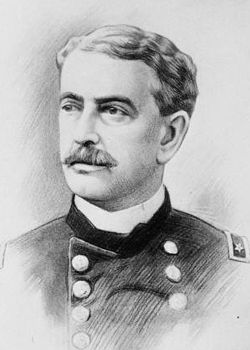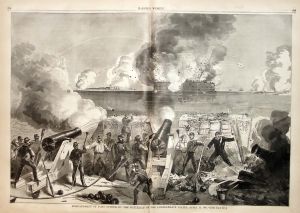At 4:30 AM, Confederate batteries open fire on Fort Sumter off the coast of Charleston, South Carolina. Sumter’s Union garrison returns fire. In the space of mere moments, month-longs apprehension evaporates. The war is on. There is no turning back.
The first return fire from Sumter comes from a cannon manned by the fort’s second in command, Captain Abner Doubleday (below illustration).
Abner is the son of Ulysses F. Doubleday (1792-1866), former U.S. Representative from New York, and an active Baptist. From Baptist roots, Abner has been serving in the U.S. military since 1842. During the war, he rises to the rank of colonel. His finest moment is during the Battle of Gettysburg, at which time he successfully leads 9500 men against a much larger force. (Doubleday is now featured in a number of displays at the Gettysburg Visitor Center.) After the war, Abner remains in the service of the U.S. military for a number of years, and later practices law in New York.
 Abner Doubleday, however, is best known as the alleged inventor of the game of baseball, in 1839 in a cow pasture in Cooperstown, New York. Baseball’s Hall of Fame, housed in Cooperstown, stands as testimony to the legend of Abner Doubleday. While evidence indicates that Doubleday is not the inventor of baseball, the myth remains.
Abner Doubleday, however, is best known as the alleged inventor of the game of baseball, in 1839 in a cow pasture in Cooperstown, New York. Baseball’s Hall of Fame, housed in Cooperstown, stands as testimony to the legend of Abner Doubleday. While evidence indicates that Doubleday is not the inventor of baseball, the myth remains.
After Doubleday returns fire upon Confederate forces at 4:30 AM, the Confederates bombard Sumter for the remainder of the day. Resistance from the garrison proves ineffective. As midnight arrives, hope of Fort Sumter holding out against the barrage is slim.
U.S. President Abraham Lincoln, however, is quietly pleased. The South has fired the first shot of an inevitable war; the North is relieved of bearing the burden of being the aggressor. In the battle for the moral high ground (the issue of slavery aside), the North wins the initial battle of public perception.
Sources: William Cathcart, Baptist Encyclopedia, Volume 2 (1883), p. 1299; Abner Doubleday information and illustration (link and link); Ulysses F. Doubleday information (link); Fort Sumter information (link) and illustration (from Harpers Weekly).



